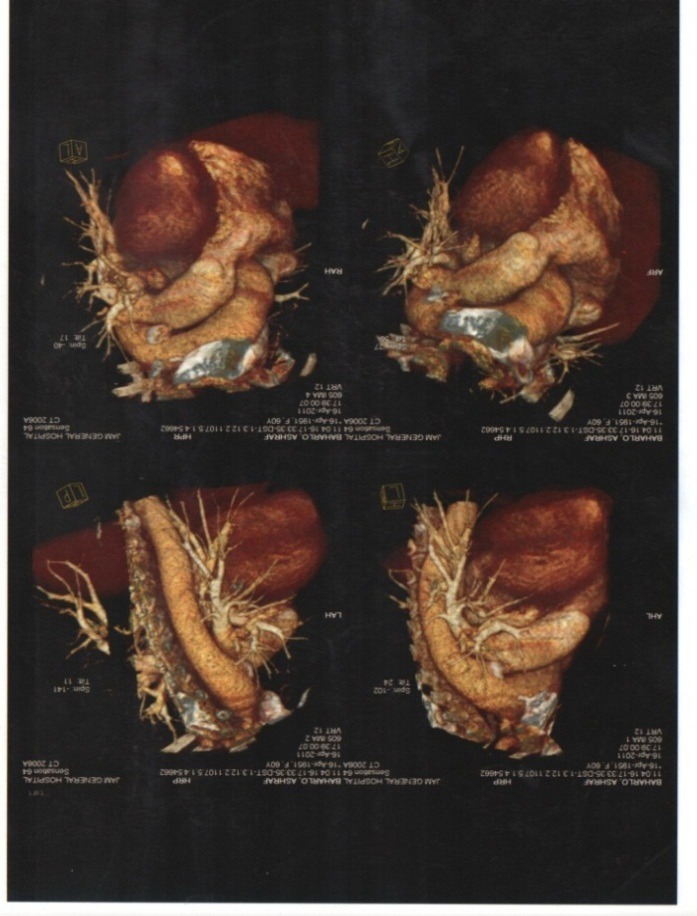Patent ductus arteriosus CT: Difference between revisions
m (Robot: Automated text replacement (-mgibson@perfuse.org +charlesmichaelgibson@gmail.com, -kfeeney@perfuse.org +kfeeney@elon.edu)) |
|||
| (7 intermediate revisions by 4 users not shown) | |||
| Line 1: | Line 1: | ||
__NOTOC__ | __NOTOC__ | ||
{{Patent ductus arteriosus}} | {{Patent ductus arteriosus}} | ||
{{CMG}}; '''Associate Editor-In-Chief:''' [[Priyamvada Singh|Priyamvada Singh, M.B.B.S.]] [mailto: | {{CMG}}; '''Associate Editor-In-Chief:''' [[Priyamvada Singh|Priyamvada Singh, M.B.B.S.]] [mailto:psingh13579@gmail.com], {{CZ}},{{RG}} '''Assistant Editor-In-Chief:''' [[Kristin Feeney|Kristin Feeney, B.S.]] [mailto:kfeeney@elon.edu] | ||
==Overview== | ==Overview== | ||
Computed tomography can be helpful as a diagnostic tool in conditions where the echocardiographic findings are inconclusive. | [[Computed tomography]] can be helpful as a diagnostic tool in conditions where the [[echocardiographic]] findings are inconclusive. | ||
==CT== | ==CT== | ||
Computed tomography (CT) can be used as a diagnostic modality in congenital heart | [[Computed tomography]] ([[CT]]) can be used as a diagnostic modality in [[congenital heart disease]]s. <ref name="GoiteinFuhrman2005">{{cite journal|last1=Goitein|first1=Orly|last2=Fuhrman|first2=Carl R.|last3=Lacomis|first3=Joan M.|title=Incidental Finding on MDCT of Patent Ductus Arteriosus: Use of CT and MRI to Assess Clinical Importance|journal=American Journal of Roentgenology|volume=184|issue=6|year=2005|pages=1924–1931|issn=0361-803X|doi=10.2214/ajr.184.6.01841924}}</ref> | ||
<ref name="MakOng2014">{{cite journal|last1=Mak|first1=MS|last2=Ong|first2=CC|last3=Tay|first3=EL|last4=Teo|first4=LL|title=Clinics in diagnostic imaging (155)|journal=Singapore Medical Journal|volume=55|issue=09|year=2014|pages=462–467|issn=00375675|doi=10.11622/smedj.2014113}}</ref> | |||
<ref name="Armand2014">{{cite journal|last1=Armand|first1=Sandbad|title=Comparison of diagnostic accuracy of dual-source CT and conventional angiography in detecting congenital heart diseases|journal=Polish Journal of Radiology|volume=79|year=2014|pages=164–168|issn=0137-7183|doi=10.12659/PJR.890732}}</ref> | |||
===Advantages=== | |||
* Provides additional [[anatomic]] details compared to [[echocardiography]]. | |||
* It is done faster compared to [[MRI]], thus avoiding the need for [[anesthesia]] in small children. | |||
===Disadvantages=== | |||
* Costly | * Costly | ||
* Radiation can have long terms side-effect on growing children. | * [[Radiation]] can have long terms side-effect on growing [[children]]. | ||
[[File:CT image showing the PDA.jpg|alt=CT image showing the PDA|center|thumb|642x642px|(a) A volume rendering [[Computed tomography|CT]] image showing the [[Patent ductus arteriosus|PDA]] (red arrow). (b) A curved planar [[Computed tomography|CT]] reformation image showing the [[Thoracic aortic aneurysm|TAA]] (red arrow; diameter, 41 mm). (c) A curved planar [[Computed tomography|CT]] reformation image showing the [[Patent ductus arteriosus|PDA]] (red arrow; diameter, 6 mm) with contrast enhancement and [[calcification]]. Case courtesy by Toshiki Kuno et al<ref>{{Cite web|url=https://www.ncbi.nlm.nih.gov/pmc/articles/PMC4336929/|title=Successful Stent Graft Insertion for Endovascular Aneurysm Repair and Closure of Patent Ductus Arteriosus in an Adult Patient|last=|first=|date=|website=|archive-url=|archive-date=|dead-url=|access-date=}}</ref>]] | |||
[[File:Computed tomographic of PDA.jpg|alt=PDA|center|thumb|916x916px|Computed tomographic angiographic findings show PDA with a 5.5-7 mm luminal width interposed between the roof of the left pulmonary artery and descending aorta. Case courtesy by Bahram Pishgoo et al<ref>{{Cite web|url=https://www.ncbi.nlm.nih.gov/pmc/articles/PMC4251482/|title=A rare presentation of patent ductus arteriosus in an adult patient with normal pulmonary hypertension and limb edema|last=|first=|date=|website=|archive-url=|archive-date=|dead-url=|access-date=}}</ref>]] | |||
<br /> | |||
==References== | ==References== | ||
{{reflist|2}} | {{reflist|2}} | ||
Latest revision as of 17:48, 13 March 2020
|
Patent Ductus Arteriosus Microchapters |
|
Differentiating Patent Ductus Arteriosus from other Diseases |
|---|
|
Diagnosis |
|
Treatment |
|
Medical Therapy |
|
Case Studies |
|
Patent ductus arteriosus CT On the Web |
|
American Roentgen Ray Society Images of Patent ductus arteriosus CT |
|
Risk calculators and risk factors for Patent ductus arteriosus CT |
Editor-In-Chief: C. Michael Gibson, M.S., M.D. [1]; Associate Editor-In-Chief: Priyamvada Singh, M.B.B.S. [2], Cafer Zorkun, M.D., Ph.D. [3],Ramyar Ghandriz MD[4] Assistant Editor-In-Chief: Kristin Feeney, B.S. [5]
Overview
Computed tomography can be helpful as a diagnostic tool in conditions where the echocardiographic findings are inconclusive.
CT
Computed tomography (CT) can be used as a diagnostic modality in congenital heart diseases. [1] [2] [3]
Advantages
- Provides additional anatomic details compared to echocardiography.
- It is done faster compared to MRI, thus avoiding the need for anesthesia in small children.
Disadvantages


References
- ↑ Goitein, Orly; Fuhrman, Carl R.; Lacomis, Joan M. (2005). "Incidental Finding on MDCT of Patent Ductus Arteriosus: Use of CT and MRI to Assess Clinical Importance". American Journal of Roentgenology. 184 (6): 1924–1931. doi:10.2214/ajr.184.6.01841924. ISSN 0361-803X.
- ↑ Mak, MS; Ong, CC; Tay, EL; Teo, LL (2014). "Clinics in diagnostic imaging (155)". Singapore Medical Journal. 55 (09): 462–467. doi:10.11622/smedj.2014113. ISSN 0037-5675.
- ↑ Armand, Sandbad (2014). "Comparison of diagnostic accuracy of dual-source CT and conventional angiography in detecting congenital heart diseases". Polish Journal of Radiology. 79: 164–168. doi:10.12659/PJR.890732. ISSN 0137-7183.
- ↑ "Successful Stent Graft Insertion for Endovascular Aneurysm Repair and Closure of Patent Ductus Arteriosus in an Adult Patient".
- ↑ "A rare presentation of patent ductus arteriosus in an adult patient with normal pulmonary hypertension and limb edema".